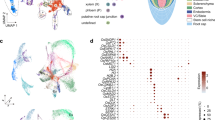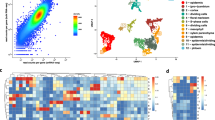Abstract
The functions of the plant body rely on interactions among distinct and nonequivalent cell types. The comparison of transcriptomes from different cell types should expose the transcriptional networks that underlie cellular attributes and contributions. Using laser microdissection and microarray profiling, we have produced a cell type transcriptome atlas that includes 40 cell types from rice (Oryza sativa) shoot, root and germinating seed at several developmental stages, providing patterns of cell specificity for individual genes and gene classes. Cell type comparisons uncovered previously unrecognized properties, including cell-specific promoter motifs and coexpressed cognate binding factor candidates, interaction partner candidates and hormone response centers. We inferred developmental regulatory hierarchies of gene expression in specific cell types by comparison of several stages within root, shoot and embryo.
This is a preview of subscription content, access via your institution
Access options
Subscribe to this journal
Receive 12 print issues and online access
$209.00 per year
only $17.42 per issue
Buy this article
- Purchase on Springer Link
- Instant access to full article PDF
Prices may be subject to local taxes which are calculated during checkout




Similar content being viewed by others
Accession codes
References
Yu, H., Xia, Y., Trifonov, V. & Gerstein, M. Design principles of molecular networks revealed by global comparisons and composite motifs. Genome Biol. 7, R55 (2006).
Birnbaum, K. et al. A gene expression map of the Arabidopsis root. Science 302, 1956–1960 (2003).
Brady, S.M. et al. A high-resolution root spatiotemporal map reveals dominant expression patterns. Science 318, 801–806 (2007).
Nelson, T., Gandotra, N. & Tausta, S.L. Plant cell types: reporting and sampling with new technologies. Curr. Opin. Plant Biol. 11, 567–573 (2008).
Nelson, T., Tausta, S.L., Gandotra, N. & Liu, T. Laser microdissection of plant tissue: what you see is what you get. Annu. Rev. Plant Biol. 57, 181–201 (2006).
Ishiwatari, Y. et al. Rice phloem thioredoxin h has the capacity to mediate its own cell-to-cell transport through plasmodesmata. Planta 205, 12–22 (1998).
Carland, F.M. & Nelson, T. Cotyledon vascular pattern2-mediated inositol (1,4,5) triphosphate signal transduction is essential for closed venation patterns of Arabidopsis foliar organs. Plant Cell 16, 1263–1275 (2004).
Petricka, J.J. & Nelson, T.M. Arabidopsis nucleolin affects plant development and patterning. Plant Physiol. 144, 173–186 (2007).
Zhan, S., Horrocks, J. & Lukens, L.N. Islands of co-expressed neighbouring genes in Arabidopsis thaliana suggest higher-order chromosome domains. Plant J. 45, 347–357 (2006).
Hurst, L.D., Pal, C. & Lercher, M.J. The evolutionary dynamics of eukaryotic gene order. Nat. Rev. Genet. 5, 299–310 (2004).
Lee, S., Jo, M., Lee, J., Koh, S.S. & Kim, S. Identification of novel universal housekeeping genes by statistical analysis of microarray data. J. Biochem. Mol. Biol. 40, 226–231 (2007).
Yang, G.X. et al. Microarray analysis of brassinosteroids- and gibberellin-regulated gene expression in rice seedlings. Mol. Genet. Genomics 271, 468–478 (2004).
Yazaki, J. et al. Transcriptional profiling of genes responsive to abscisic acid and gibberellin in rice: phenotyping and comparative analysis between rice and Arabidopsis. Physiol. Genomics 17, 87–100 (2004).
Liu, X. et al. A G protein-coupled receptor is a plasma membrane receptor for the plant hormone abscisic acid. Science 315, 1712–1716 (2007).
Razem, F.A., El-Kereamy, A., Abrams, S.R. & Hill, R.D. The RNA-binding protein FCA is an abscisic acid receptor. Nature 439, 290–294 (2006).
Shen, Y.Y. et al. The Mg-chelatase H subunit is an abscisic acid receptor. Nature 443, 823–826 (2006).
Abe, H. et al. Arabidopsis AtMYC2 (bHLH) and AtMYB2 (MYB) function as transcriptional activators in abscisic acid signaling. Plant Cell 15, 63–78 (2003).
Edwards, D., Murray, J.A. & Smith, A.G. Multiple genes encoding the conserved CCAAT-box transcription factor complex are expressed in Arabidopsis. Plant Physiol. 117, 1015–1022 (1998).
Lotan, T. et al. Arabidopsis LEAFY COTYLEDON1 is sufficient to induce embryo development in vegetative cells. Cell 93, 1195–1205 (1998).
Coustry, F., Sinha, S., Maity, S.N. & Crombrugghe, B. The two activation domains of the CCAAT-binding factor CBF interact with the dTAFII110 component of the Drosophila TFIID complex. Biochem. J. 331, 291–297 (1998).
Gusmaroli, G., Tonelli, C. & Mantovani, R. Regulation of novel members of the Arabidopsis thaliana CCAAT-binding nuclear factor Y subunits. Gene 283, 41–48 (2002).
Ma, L. et al. A microarray analysis of the rice transcriptome and its comparison to Arabidopsis. Genome Res. 15, 1274–1283 (2005).
Churchill, G.A. Fundamentals of experimental design for cDNA microarrays. Nat. Genet. 32 Suppl, 490–495 (2002).
Kulldorff, M., Rand, K., Gherman, G., Williams, W. & DeFrancesco, D. SaTScan v2.1: software for the spatial and space-time scan statistics. US National Cancer Institute 〈http://www.cancer.gov/prevention/BB/SaTScan.html##〉 (1998).
Eisen, M.B., Spellman, P.T., Brown, P.O. & Botstein, D. Cluster analysis and display of genome-wide expression patterns. Proc. Natl. Acad. Sci. USA 95, 14863–14868 (1998).
Saldanha, A.J. Java Treeview–extensible visualization of microarray data. Bioinformatics 20, 3246–3248 (2004).
Beissbarth, T. & Speed, T.P. GOstat: find statistically overrepresented Gene Ontologies within a group of genes. Bioinformatics 20, 1464–1465 (2004).
Du, L. et al. The two-component signal system in rice (Oryza sativa L.): a genome-wide study of cytokinin signal perception and transduction. Genomics 89, 697–707 (2007).
Ito, Y. & Kurata, N. Identification and characterization of cytokinin-signalling gene families in rice. Gene 382, 57–65 (2006).
Jain, M. et al. Structure and expression analysis of early auxin-responsive Aux/IAA gene family in rice (Oryza sativa). Funct. Integr. Genomics 6, 47–59 (2006).
Acknowledgements
We thank N. Li for valuable database advice and assistance and P. Wu (Zhejiang University) for the rice root micrograph in Figure 3. This work was supported by US National Science Foundation Plant Genome Program grant DBI-0325821 to T.N., X.-W.D. and H.Z. T.L. and M.C. were supported in part by Peking-Yale Monsanto Fellowships.
Author information
Authors and Affiliations
Contributions
T.N., X.-W.D. and H.Z. conceived and oversaw the research. S.L.T., N.G. and T.L. performed cell isolations, RNA isolations and informatic analysis. Y.J., H.Z. and L.M. performed microarray hybridizations and informatic analysis. T.C., N.K.C. and M.C. performed cell and RNA isolations. N.S. designed and performed statistical methods for data processing and analysis. M.H. designed and implemented the atlas database and analytical tools. T.N. prepared the manuscript, with assistance from all coauthors.
Note: Supplementary information is available on the Nature Genetics website.
Corresponding author
Supplementary information
Supplementary Text and Figures
Supplementary Methods, Supplementary Figures 1–6 and Supplementary Tables 1–4 (PDF 2128 kb)
Rights and permissions
About this article
Cite this article
Jiao, Y., Lori Tausta, S., Gandotra, N. et al. A transcriptome atlas of rice cell types uncovers cellular, functional and developmental hierarchies. Nat Genet 41, 258–263 (2009). https://doi.org/10.1038/ng.282
Received:
Accepted:
Published:
Issue Date:
DOI: https://doi.org/10.1038/ng.282
This article is cited by
-
Cytological, transcriptome and miRNome temporal landscapes decode enhancement of rice grain size
BMC Biology (2023)
-
A novel adenylate isopentenyltransferase 5 regulates shoot branching via the ATTTA motif in Camellia sinensis
BMC Plant Biology (2021)
-
Genome-wide analysis of spatiotemporal expression patterns during rice leaf development
BMC Genomics (2021)
-
Two Clade A Phosphatase 2Cs Expressed in Guard Cells Physically Interact With Abscisic Acid Signaling Components to Induce Stomatal Closure in Rice
Rice (2019)
-
A gene expression map of shoot domains reveals regulatory mechanisms
Nature Communications (2019)



